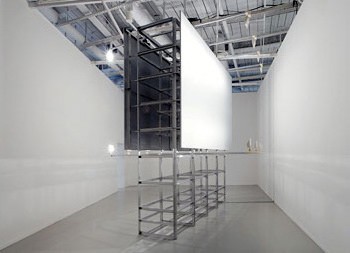
Sirous Namazi , Skylt © Sirous Namazi
Odd weeks: Sirous Namazi
Sign
7.4 2003 – 20.4 2003
Stockholm
Whereas a billboard in its usual place is surrounded by an open space, this one is crammed into the white cube of the Odd Weeks exhibitions. The shiny aluminium sculpture almost seems to burst the room. 16 lights on each side illuminate the vast aluminium surfaces. We stretch upwards to see what’s on the billboard. But Sirous Namazi does not satisfy our expectations – there is no advert to be seen.
The transition from public space to exhibition hall causes a gap in the meaning, which is widened by the exposed emptiness. The surface instead becomes a mirror that confronts us with our own expectations. The light reflected in the polished surface becomes a metaphor for how we might reflect when our expectations encounter emptiness: How does communication take place in the public sphere? How does consumption work – and how does advertising induce our desire?
The sculpture Periphery is shown outside the cube – it was recently added to the Moderna Museet collection. Again, Sirous Namazi – who moved to Sweden from Iran in his early teens – moves the object, a typical balcony with a dish receiver, from an immigrant suburb to the museum context. Our thoughts and questions about what kind of a room a balcony actually is can start.
The balcony is a place in between the private and public spheres. It is a room that is separate from the surroundings and which makes you feel separated from what lies beyond – you are not quite part of it – and yet, it is a room that protects you from the surroundings. It’s like standing in a watchtower or a rostrum, raised above the masses, where you can look at the others, but you can also be seen by others. And as your gaze from the balcony is aimed outwards, the world flows in through the dish receiver, often in the form of broadcasts from your native country.
Periphery looks like a balcony, but in reality it is no more a balcony than Sign is a billboard. Both are sculptures: Sign and Periphery are not merely contextual transplants that focus social issues and reflect contemporary society – they are also dialogues with a minimalist sculptural tradition, in which spatial experience and formal reduction are essential features.
In the video Sirous telling jokes (1996), which is shown in the cinema, Sirous Namazi tells jokes in his native tongue, Iranian. Here, too, we are cheated. Suddenly, we are the foreigners, since we don’t understand the language. Now we are the ones who are excluded.
Curator: Iris Müller-Westermann
